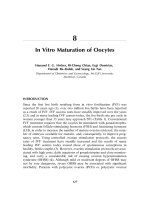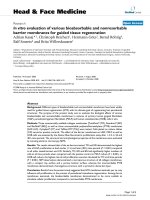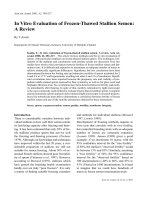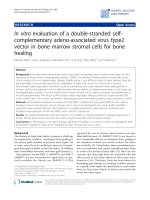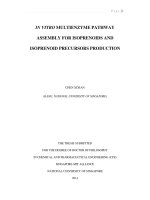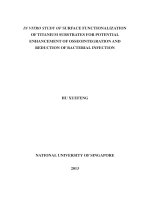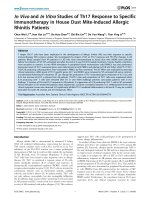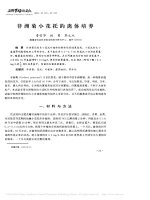In vitro evaluation of fungicides plant extracts and bio-agents against alternaria Helianthi causing leaf blight of sunflower
Bạn đang xem bản rút gọn của tài liệu. Xem và tải ngay bản đầy đủ của tài liệu tại đây (391.49 KB, 8 trang )
Int.J.Curr.Microbiol.App.Sci (2019) 8(2): 1632-1639
International Journal of Current Microbiology and Applied Sciences
ISSN: 2319-7706 Volume 8 Number 02 (2019)
Journal homepage:
Original Research Article
/>
In vitro Evaluation of Fungicides Plant Extracts and Bio-agents against
Alternaria helianthi causing Leaf Blight of Sunflower
G. Mahadevaswamy1*, G. Vijayalakshmi2 and G. Gangadharanaik1
1
Department of Plant Pathology, University of Agricultural and Horticultural Sciences,
Shimoga, Karnataka, India – 577 225
2
Department of Plant Pathology, University of Agricultural Sciences,
Bengaluru -560065, India
*Corresponding author
ABSTRACT
Keywords
In-vitro evaluation,
Fungicides, Plant
extracts, Bio agents,
Alternaria helianthi
Article Info
Accepted:
14 January 2019
Available Online:
10 February 2019
Alternaria leaf blight of sunflower caused by Alternaria helianthi is an important disease
of sunflower. The study conducted on in vitro evaluation of new molecules of fungicides
and plant extracts against Alternaria helianthi, causal agent of Alternaria blight of
sunflower. In vitro evaluation of fungicides revealed that, among four systemic fungicides
hexaconazole and propiconazole were highly effective in inhibiting the mycelial growth
with 100% inhibition among non systemic fungicides the maximum inhibition of mycelial
growth was found in captan (86.30%) at 600 ppm concentration followed by copper oxy
chloride (84.07%) whereas, among the botanicals neem seed kernel extracts at 10 per
cent(43.74%) showed positive effect on inhibition of pathogen mycelium growth followed
by neem leaf extracts(25.26%). Trichoderma harzianum shows the best bio agents against
Alternaria helianthi with highest per cent inhibition (72.48%).
Introduction
Sunflower (Helianthis annuus L.) belongs to
the family Asteraceae and it is one of the most
important edible oilseed crops in India. It is a
hardy and an herbaceous annual, which grows
up to a height of 5 feet. The word Helianthus
is derived from Greek word ‘Helios’ (sun)
and ‘anthos’ (flower).Presently in India
Sunflower crop is cultivated in an area of
0.487 million hectares with a production of
296 MT and a productivity of 608 kg/ha
(Anon, 2017). The Alternaria leaf blight is a
major disease of sunflower which causes an
average yield and oil losses in India ranged
from 28 to 80 per cent and 31 to 34 per cent,
respectively. There is very negligible resistant
variety/hybrid available against this disease
on sunflower. Thus it has become inevitable
to go for fungicidal spray for the management
of the disease. In the present study some of
the new chemicals were tested in the
laboratory to find out their efficacy against
A. helianthi.
Materials and Methods
1632
Int.J.Curr.Microbiol.App.Sci (2019) 8(2): 1632-1639
Systemic fungicides
A study has been conducted at Department of
Plant Pathology, College of Agriculture
Navile, Shimoga to know the efficacy of
systemic fungicides, non-systemic fungicides
and leaf extracts (four each) against A.
helianthi was assessed by following poison
food technique. Both Systemic fungicides and
non-systemic fungicides were evaluated at
100, 200, 400 and 600 ppm concentrations
and plant extracts were taken at 2.5, 5 and 10
percent each were evaluated. These were
assessed by Poison food technique and the
efficacy of the fungicides was expressed as
per cent inhibition of mycelial growth over
control, which was calculated by using the
formula.
Where,
I = per cent inhibition
C = pathogen growth in control plate
T = pathogen growth in treatment plate
The plant extracts were prepared by grinding
fresh leaves in a pestle and mortar by using
sterile distilled water. The extract was filtered
through double layered muslin cloth and
made to the required concentration by adding
distilled water.
The details of fungicides / plant extracts
tested are given below.
1
2
3
4
4
Mancozeb 75 WP
Carbendazim 50
WP
Hexaconazole 5 EC
Propiconazole 25
EC
Thiophanate methyl
75WP
Bavistin
Nectar
Tilt
Roko
Preparation of cold aqueous extract
Fresh plant materials were collected and
washed first in tap water and then in distilled
water. Hundred grams of fresh sample was
chopped and then crushed in a surface
sterilized pestle and mortar by adding 100 ml
sterile distilled water (1:1 w/v). The extracts
were filtered through two layers of muslin
cloth and then through Whatman No. 1 filter
paper. Finally filtrate thus obtained was used
as stock solution. Nimbicidin as commercial
formulation available in the market was used.
To study the compatibility as well the
antifungal mechanism of plant extracts the
poisoned food technique was used (Nene and
Thapliyal, 1982). The efficacy of plant
products or botanicals was expressed as per
cent of radial growth/cfu over the control
which was calculated using the formula
(Vincent, 1947).
Plant extracts
Sl.
No. Common Name
Neem seed
1
kernel extract
Neem leaves
2
extract
Kari jaali leaves
3
extract
Chromolina
4
leaves extract
Non systemic fungicides
Sl. No. Fungicides
Captan 50 WP
1
Chlorothalonil 75 WP
2
Copper oxy chloride
50 WP
3
Trade
Name
Sl. No. Common Name
Trade
Name
Captaf
Kavach
Blitox
Indofil M45
1633
Scientific
name
Azadirachta
indica
Azadirachta
indica
Prosopis
juliflora
Chromolina
odonata
Int.J.Curr.Microbiol.App.Sci (2019) 8(2): 1632-1639
Dual culture technique for bioagents
Twenty ml of sterilized and cooled potato
dextrose agar medium was poured into sterile
Petri plates and allowed to solidify. For
evaluation of fungal bio-control agents,
mycelial discs of test fungus were inoculated
at one end of the Petri plate and antagonistic
fungus was placed opposite to it on the other
end. In case of evaluation of bacterial
antagonist, the bacterium was streaked one
day earlier at one end of the Petri plate to the
middle of the Petri plate and the test fungus
placed at the other end. The plates were
incubated at 27±1°C and zone of inhibition
was recorded by measuring the clear distance
between the margin of the test fungus and
antagonistic organism. The colony diameter
of pathogen in control plate was also
recorded. The per cent inhibition of growth of
the pathogen was calculated by using the
formula suggested by Vincent (1947).
Where,
I = per cent inhibition
C = growth of pathogen in control
T = growth of pathogen in treated plate
List of Bio agents used for study
Sl no
Bio agents
1
Trichodermaviride (IIHR)
2
T. harzianum(Local)
Pseudomonas fluorescens (local
3
strain)
4
P. fluorescens (IIHR)
against A. helianthi by following poison food
technique. The data are presented in Table 1
and 2.
Among different non systemic fungicides
tested at 100 ppm the highest inhibition of
radial growth was recorded by Captan
(50.74%) which differed significantly from
other fungicide tested Mancozeb and
Chlorothlonil with an inhibition of 35.93 per
cent and 29.63 percent respectively. Whereas,
Copper oxychloride (17.41%) recorded the
least inhibition (Table 1). At 200 ppm Captan
recorded the highest inhibition of colony
radial growth by 80.86 per cent, followed by
Copper oxy chloride (51.48%) and the least
inhibition was recorded in Chlorothlonil
(35.74%). The highest inhibition of radial
growth of 80.86 percent was recorded with
Captan at 400 ppm which is superior and
significantly differed from other fungicides
tested, followed by Copper oxy chloride,
Mancozeb with an inhibition of 64.44 per cent
and 64.63 percent respectively and was on par
with each other. At 600 ppm Captan recorded
the highest inhibition of radial growth of
50.74 per cent, which significantly differed
from other fungicides tested, followed by
Copper oxy chloride (84.07%) and the least
inhibition was recorded by Chlorothalonil
(47.79%) (Fig. 1).
Among different systemic fungicides tested at
100 ppm the highest inhibition of radial
growth was recorded by Hexaconazole
(93.52%), followed by Propiconazole
(92.59%) and were on par and significantly
superior over other fungicides. Followed by
Thiophanate
methyl
(22.41%)
and
Carbendazim (18.15%) (Table 2 and Fig. 2).
Results and Discussion
In vitro evaluation of fungicides against A.
helianthi
Four non-systemic and four systemic
fungicides were evaluated for their efficacy
The 100 per cent inhibition of radial growth
was recorded by Hexaconazole at 200 ppm
whereas;
Propiconazole
recorded
the
inhibition of 93.70 per cent, followed by the
thiophanate
methyl
(34.07%)
and
Carbendazim (24.63%).
1634
Int.J.Curr.Microbiol.App.Sci (2019) 8(2): 1632-1639
SL. No
1
2
3
4
Table.1 In vitro evaluation of systemic fungicides against A. helianthi
Fungicides
Per cent inhibition of Radial growth(mm)
100 ppm
200 ppm
400 ppm
600 ppm
Carbendazim
18.15
24.63
39.07
44.44
Thiophanate methyl
22.41
34.07
40.37
46.11
Propiconazole
92.59
93.7
100
100
Hexaconazole
93.52
100
100
100
56.67
63.1
69.86
72.63
Mean
Fungicides (F)
concentrations (C)
FxC
SL
No
1
2
3
4
CD at 1%
1.11
1.12
2.24
CD at 5%
0.92
3.57
7.16
Table.2 In vitro evaluation of non-systemic fungicides against A. helianthi
Fungicides
Per cent inhibition of Radial growth(mm)
100 ppm
200 ppm
400 ppm
600 ppm
Mancozeb
35.93
48.89
64.63
73.89
Captan
50.74
80.56
85.56
86.3
Chlorothalonil
29.63
35.74
39.07
47.59
Copper oxy chloride
17.41
51.48
64.44
84.07
33.42
54.16
63.42
72.96
Mean
Fungicide (F)
Concentrations (C)
FxC
SL
No
1
2
3
4
S.Em±
0.29
0.29
0.58
S.Em±
0.56
0.56
1.13
CD at 1%
2.20
2.19
4.39
CD at 5%
1.64
6.34
12.67
Table.3 In vitro evaluation of plant extracts against A. helianthi
Plant extracts
Per cent inhibition of radial growth(mm)
2.50%
5%
10%
Neem seed kernel extract
22.78
33.89
43.74
Neem leaf extract
11.67
19.44
25.26
Chromolina leaf extract
6.74
19.33
22.93
Prosopis leaf extract
10.56
16.11
23.89
Plant extracts(P)
concentration (C)
PxC
S.Em±
0.29
0.29
0.58
1635
CD at 1%
1.13
1.13
2.27
Mean
33.47
18.75
16.37
16.85
Int.J.Curr.Microbiol.App.Sci (2019) 8(2): 1632-1639
Table.4 Efficacy of different bio-agents against A. helianthi under in vitro
Bio agents
Per cent inhibition over
control
60.81
Trichodermaviride
72.48
T. harzianum
39.41
Pseudomonas fluorescens (local strain)
36.31
P. fluorescens (IIHR)
1.21
S.Em±
3.96
CD at 5%
1636
Int.J.Curr.Microbiol.App.Sci (2019) 8(2): 1632-1639
At 400 ppm, 100 percent inhibition of radial
growth was observed with Hexaconazole and
Propiconazole and these differed significantly
compared to other fungicide tested.
These were followed by the Thiophanate
methyl (40.37%) and Carbendazim (39.07%).
At 600 ppm Hexaconazole and Propiconazole
was found to be superior over other
fungicides tested with 100 per cent inhibition
of fungal radial growth followed by COC
(84.07%), Thiophanate methyl (40.37%) and
Carbendazim (39.07%). These results in
conformity with the results of Mesta et al.,
(2009) reported that Hexaconazole (63.12 %
and 72.87 % respectively) and Propiconazole
(61.80 and 76.53 %) were most effective and
were found on par.
Thaware et al., (2010) reported that among
different fungicides tested in vitro, Mancozeb
(0.2 per cent) and Propiconazole (0.05 per
cent) completely inhibited the growth of the
test fungus.
1637
Int.J.Curr.Microbiol.App.Sci (2019) 8(2): 1632-1639
Chethana et al., (2012) recorded that
Mancozeb and Propineb (0.3%) caused 100
per cent inhibition of mycelia growth. This
was also in confirmation with the work
specified Vasudha et al., (2018) reported that
Propiconazole
(100%)
followed
by
Hexaconazole (99.38%)
In vitro evaluation plant extracts against A.
helianthi
As natural products isolated from plant
appears to be one of the best alternatives in
plant disease management as they are known
to have minimal environmental impact and
danger to consumers in contrast to synthetic
pesticides. Among different plant extracts
tested NSKE at 10 per cent showed maximum
inhibition of 43.74 per cent, followed by
Neem leaf extracts (25.26%), karijaali
(23.89%) whereas, Chromolina leaf extract
recorded the least (22.93 %) represented in
Table 3 and figure 3. At 5 per cent the
maximum inhibition of 33.89 per cent was
recorded by NSKE which significantly
differed compared to others, followed by
Neem leaf extracts (19.44%) and karijaali leaf
extracts (16.11 %). At 2.5 percent also the
maximum inhibition was recorded with
NSKE (22.78%) and the least was inhibition
was recorded by chromolina (6.74%). The
present study agrees with the findings of who
observed, among the extract tested Neem seed
kernel extract (NSKE) was found superior
compared to other plant extracts tested against
A. helianthi under in vitro condition.
In vitro evaluation of bio-agents against A.
helianthi
From the observation it was revealed that, the
maximum reduction in colony growth of A.
helianthi was recorded in T. harzianum
(72.48%) treated plates which was
significantly superior over all other bio-agents
tested. However T. viride (60.81%),
Pseudomonas fluorescens (39.41%) of local
strain were also effective in inhibiting the
growth of fungus. However the least
inhibition of mycelia was noticed in
Pseudomonas fluorescens (36.31%) IIHR
strain (Table 4 and Fig. 4).
These findings were in conformity with the
observation made by Amaresh (2000),
Chethana et al., (2012), Mesta (2006) and
Kota (2003) reported that among the biocontrol agent T. viride and T. harzianum were
effectively inhibited the growth of A.
helianthi while the bacterium P. fluorescens
produced maximum inhibition zone.
References
Amaresh, Y. S., 2000, Epidemiology and
management of Alternaria leaf blight
and rust of sunflower (Helianthus
annus L.). Ph.D. Thesis, Univ. Agric.
Sci. Dharwad, Pp. 320.
Anonymous, 2017, Food and Agriculture
Organization (FAO) stat 2016-17.
Chethana B. S., Girija G, Archana, S. Rao,,
Bellishree K (2012) In vitro evaluation
of plant extracts, bioagents and
fungicides against Alternaria porri
(Ellis) Cif. causing purple blotch
disease of onion. Pest Management in
Horticultural Ecosystems, 18(2): 194198
Kota, V., 2003, Biological management of
post-harvest fungal diseases of major
fruits. M.Sc. (Agri) Thesis, Univ.
Agric. Sci., Dharwad.
Mesta RK, Benagi VI, Srikant Kulkarni,
ShankergoudI (2009). In vitro
evaluation of fungicides and plant
extracts against Alternaria helianthi
causing
blight
of
sunflower.
Karnataka J. Agric. Sci., 22(1):111114.
Mesta, R. K., 2006, Epidemiology and
management of Alternaria blight of
sunflower caused by Alternaria
1638
Int.J.Curr.Microbiol.App.Sci (2019) 8(2): 1632-1639
helianthi
(hansf.)
Tubaki
and
Nishihara. PhD Thesis, Univ. Agric.
Sci., Dharwad, p.181
Nene, Y. L. And Thapliyal, P. N., 1982,
Fungicide in Plant Diseases Control,
III (Edition: Oxford and IBH
publishing Co. Pvt. Ltd., New Delhi, p.
325.
Thaware DS, Fugro PA, Jadhav YT, Magar
SV,, Karande RA (2010) In vitro
evaluation of fungicide, plant extracts
and bio-agents AGAINST Alternaria
alternate (fr.) keissler causing leaf
blight if cowpea. Int. J. Pl. Protect,
3(2):356-360.
Vasudha, A. K., Dhutraj, D.N., and Pawar,
D.V. 2017. In vitro evaluation of
different fungicides against Alternaria
alternate causing leaf and fruit spot in
pomegranate, Int. J. Curr. Microbiol.
App. Sci. 7(10): 2292-2298
Vincent, J. M., 1947, Distortion of fungal
hypae in the presence of certain
inhibitors. Nature, 159: 239-241.
How to cite this article:
Mahadevaswamy, G., G. Vijayalakshmi and Gangadharanaik, G. 2019. In vitro Evaluation of
Fungicides Plant Extracts and Bio-agents against Alternaria helianthi causing Leaf Blight of
Sunflower. Int.J.Curr.Microbiol.App.Sci. 8(02): 1632-1639.
doi: />
1639
